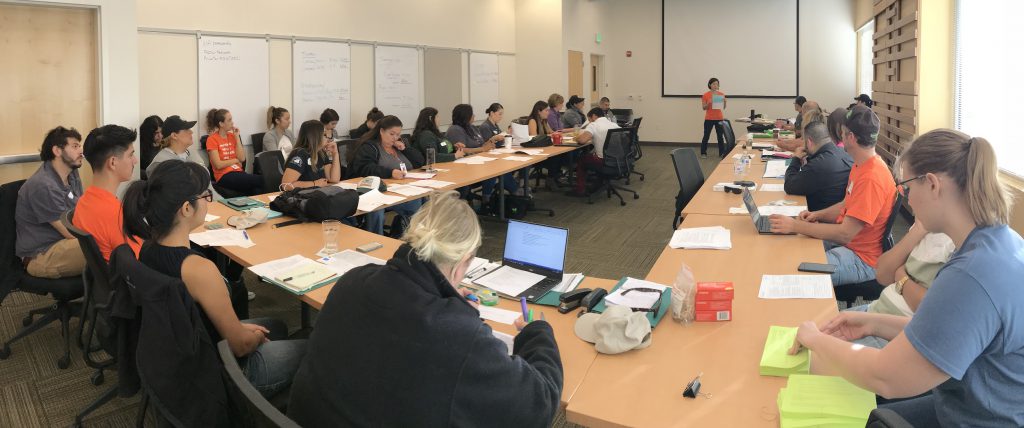Spotlight on Disaster CalFresh Efforts Following the Wildfires
noviembre 20, 2017
No ofrecemos comida. Aquí es donde puedes Encuentre comida gratis aquí.
No distribuimos alimentos. Encuentre comida gratis aquí.
我們不直接提供食物,但我們能幫助您找尋食物。

California sits in the wake of one of the largest natural disasters on record. The wild fires that began on October 8 in Northern California burned nearly 200,000 acres. With over 5,500 homes destroyed, entire neighborhoods gone, and many jobs lost, tens of thousands of people are displaced and struggling to comprehend starting over at square one.
Disasters were formally declared in eight counties across the state, seven of which were in Northern California. Navigating so many disasters at once put tremendous pressure on state partners. Local response efforts were in full swing, boosted by an outpouring of much-needed support from across the state and the nation. Aside from the obvious destruction of the fire, there was less visible damage. Food chain supplies were disrupted, some households that lost power had refrigerators full of spoiled food, and the local workforce missed out on at least a week’s worth of wages. Because community efforts alone can’t do the job when facing disasters of this size, we have government programs designed to support people facing hardship.
The road to recovery is long and daunting. One of the first steps is the coverage of basic human needs. Many national, state and local disaster efforts were automatically triggered when the fires began. We are proud to have contributed to the disaster food response on several levels at CAFB, as with our Farm to Family team managing multiple truckloads of donated produce and other food. Additionally, our CAFB family coordinated the Disaster CalFresh* outreach response. We’d like to share a bit about what that looked like on the ground in Sonoma County.
Sonoma County is located in the northern Bay Area, its city center is Santa Rosa. Santa Rosa was hit the hardest by the Tubbs Fire wherein three large neighborhoods were destroyed–Fountaingrove, Larkfield and Coffey Park–totaling 3,000 homes. Our outreach efforts focused on this area. However, a result of this type of disaster is displacement. On day one, after fine tuning our outreach message, groups dispatched to the farthest corners of the county. Outreach teams went to shelters, Local Assistance Centers (LAC), food bank distribution lines, campgrounds, RV parks, motels, community centers, bars, churches, businesses, coffee shops and gas stations to try and reach eligible individuals. We reached out to other agencies and organizations focused on different components of the disaster. We printed and brought a flyer for every child to each school in the affected area. We talked with every grocery store..
From Wednesday October 25 through November 1, outreach teams canvased every inch of Sonoma County. Several CAFB staff coordinated the efforts in partnership with Redwood Empire Food Bank and Catholic Charities of Santa Rosa, led by CAFB Director of Programs Stephanie Nishio and organized by Edith Martinez and Sarah Palmer DeFrank, along with the help of Micheline Proctor and Andrew Cheyne. Teams from Alameda County Community Food Bank, Code for America, Food Bank of Contra Costa and Solano, Placer Food Bank, River City Food Bank, Sacramento Food Bank and Family Services, San Francisco-Marin Food Bank, Second Harvest Food Bank of Santa Clara and San Mateo Counties, Second Harvest Food Bank of Santa Cruz County, and the United Farmworkers Union Foundation came to assist the local effort already under way in Sonoma County. The experienced outreach workers were well versed in CalFresh processes and providing information in a compassionate and culturally competent way. Most were Spanish speakers, increasing the ability to connect with people in the community and help at the county office.
We were happy to be able to provide backup to staff at Redwood Empire Food Bank and Catholic Charities of Santa Rosa. Most had not had a day off since the fires began. They were tired and trying to process their own pain and loss while continuing to help others. Their work was a true testament to the grit and compassion of these local heroes.
We truly appreciate every member food bank and partner who sent outreach teams, operations staff, trucks, food, and other supplies. We are grateful for the donors and volunteers who gave money and time to help put people’s lives back on track.
*Disaster CalFresh is a program specifically made available to community members who have experienced loss as a result of a disaster legally recognized by local, state and federal administrations. The program is delivered much like the SNAP/CalFresh benefit via an electronic benefit transfer card—or EBT card—however many of the means tested requirements are waived. The eligibility requirements for Disaster CalFresh are that the applicant household experience one or more of the following adverse events: damage to home or self-employment property, accrued disaster-related expenses, a disruption in income, or is unable to access liquid resources.